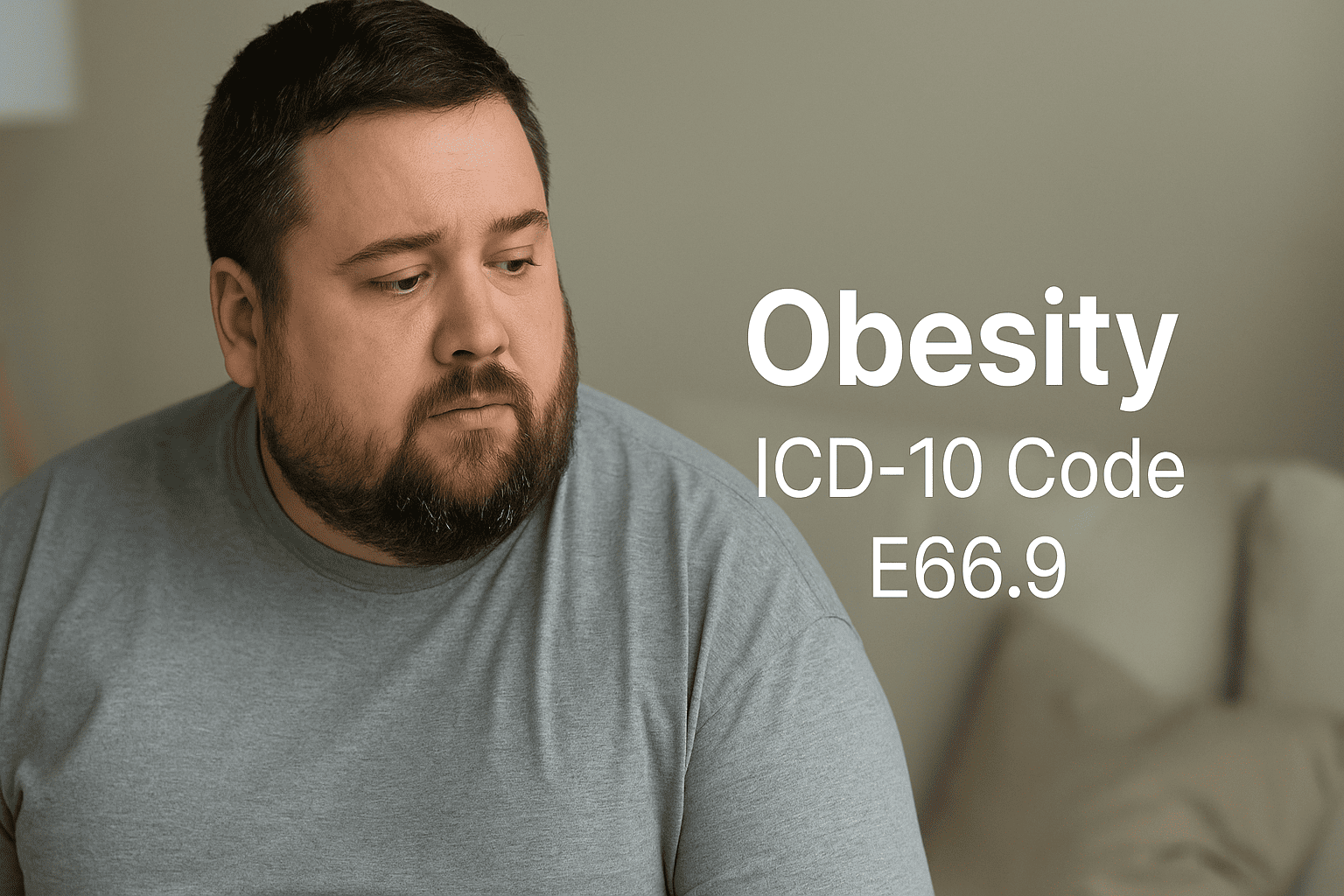Updated on: July 25, 2025
Obesity is a chronic condition involving excessive body fat accumulation that impairs health and increases the risk of conditions like type 2 diabetes, hypertension, cardiovascular disease, and sleep apnea. The ICD-10 code E66.9 is used when a provider documents obesity but does not specify the type, degree, or cause.
ICD-10 Code E66.9: Code Breakdown
-
E66 = Overweight and obesity
-
.9 = Obesity, unspecified
Use E66.9 when:
-
The diagnosis of obesity is confirmed
-
There is no mention of severity (e.g., BMI >30, >40)
-
The obesity is not due to a known cause (e.g., drug-induced, genetic)
-
The type (morbid, exogenous, etc.) is not described
✅ This is a default placeholder code, useful when BMI is recorded but no further clinical detail is added.
More Specific ICD-10 Codes for Obesity
| ICD-10 Code | Description |
|---|---|
| E66.01 | Morbid obesity due to excess calories |
| E66.2 | Morbid obesity with alveolar hypoventilation |
| E66.3 | Overweight |
| E66.8 | Other obesity |
| E66.9 | Obesity, unspecified |
📌 Always update to a more specific code when the cause or severity becomes known.
When to Use E66.9
Use E66.9 for:
-
General obesity documentation during health checkups or annual exams
-
New patient visits where BMI is >30 but no detailed workup has been done
-
Claims that require initial diagnosis before assigning morbid or severe obesity codes
-
Obesity documented without clear link to behavior, medication, or genetics
Sample Documentation:
“BMI today is 32.2. Patient reports fatigue and joint pain. Diet and exercise counseling provided. Assessment: Obesity, unspecified (E66.9).”
When Not to Use E66.9
Avoid using E66.9 if:
-
BMI is ≥40 (morbid obesity) → Use E66.01
-
The obesity is medication-induced → Use E66.1
-
The provider documents severity class or clinical complications
-
The patient has obesity-related hypoventilation → Use E66.2
🔎 Payers and quality programs prefer specific ICD-10 coding to justify risk and intervention.
Required Documentation Elements for E66.9
To support this code:
-
Document BMI ≥30 (check WHO and CDC charts)
-
Record weight history (fluctuations, prior interventions)
-
Note any counseling or referrals provided
-
Mention comorbidities (e.g., diabetes, joint pain, fatigue)
✅ Link the obesity diagnosis with intervention: lifestyle advice, nutrition plan, or medication.
BMI Coding Tips for Pairing with E66.9
| Age Group | BMI ICD-10 Code | Use With |
|---|---|---|
| Adults (≥20 yrs) | Z68.30–Z68.45 | E66.9 |
| Pediatric (<20) | Z68.51–Z68.54 | E66.9 |
Example:
E66.9 (Obesity, unspecified) + Z68.41 (BMI 40.0–44.9)
Commonly Paired ICD-10 Codes
| Associated Condition | ICD-10 Code |
|---|---|
| Hypertension | I10 |
| Type 2 diabetes | E11.9 |
| Sleep apnea | G47.33 |
| Fatty liver disease (NAFLD) | K76.0 |
| Depression (weight-related) | F32.9 |
| Osteoarthritis of knee | M17.9 |
| Nutritional counseling | Z71.3 |
| Physical activity counseling | Z71.89 |
💡 These reflect obesity comorbidity burden for HCC and quality scoring.
Treatment & Clinical Workflow
-
Initial assessment: BMI, waist circumference, vitals
-
Determine readiness for change (stage of behavior)
-
Intervention plan:
-
Dietitian referral
-
Structured weight loss programs
-
Medication (e.g., GLP-1s, orlistat)
-
Bariatric surgery consult (if BMI >40 or >35 with comorbidity)
-
-
Documentation:
-
Goals set (e.g., 5–10% weight loss)
-
Timeframe for recheck
-
Shared decision-making
-
DocScrib captures this workflow and auto-populates obesity templates and care plans.
How DocScrib Supports Obesity Documentation
In high-volume clinics, obesity is frequently undercoded or misdocumented. DocScrib’s AI scribe helps by:
-
Extracting BMI and vitals from EHR automatically
-
Suggesting specific obesity codes based on chart data
-
Auto-generating lifestyle and medication counseling text
-
Tracking changes in BMI and updating problem lists
👉 Discover how DocScrib boosts chronic care documentation →
Frequently Asked Questions
Can I use E66.9 without calculating BMI?
Yes, if obesity is documented clinically (e.g., “obese appearance”), but coding with Z68.x BMI codes is strongly advised.
What if the patient refuses to discuss weight management?
Still code E66.9 if the condition is present and documented, and note that intervention was declined.
Should I always update to E66.01 when BMI >40?
Yes. E66.01 better reflects risk, supports medication approvals, and aligns with CMS/HCC models.
Conclusion
ICD-10 Code E66.9 is a valid starting point for general obesity diagnosis, especially in primary care. However, for improved risk scoring, payer approval, and clinical decision-making, providers should aim to use more specific obesity codes when possible. With AI documentation support from DocScrib, coding and managing obesity becomes accurate, consistent, and effortless.
